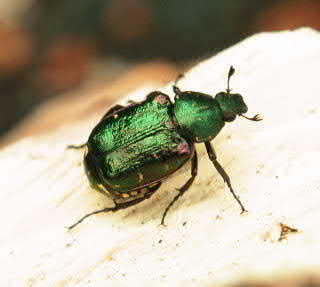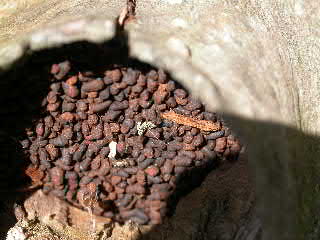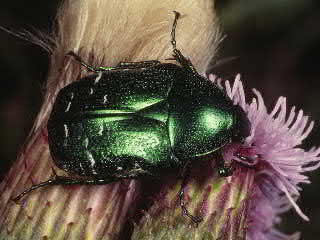
Worcestershire Record No. 18 April 2005 pp. 23-24
Harry Green
Following on from my article in November 2004 Worcestershire Record this one is to remind readers to keep a lookout for this rare beetle. It is of course large, mainly green, and flies on very hot summer days. Otherwise its life cycle is dependent on decaying fruit trees.
Since the previous article, and through help from Rob Havard of FWAG, two new sites have been recorded near Churchill and one at Phepson. In April I also found indications of the beetle in an orchard at Eckington and another near Marsh Common, Defford. At the latter site active larvae were found and their identity confirmed by Paul Whitehead. At Churchill 22 of 54 old plum trees contained evidence of noble chafers
Noble Chafers are surprisingly elusive, partly because they are rarely seen on the wing although they are occasionally seen visiting flowers such as hogweed and meadow sweet in hot summer weather. Fortunately, as the larvae eat their way through the decaying hearts of fruit trees, they leave behind masses of characteristic droppings (frass) which are quite hard and granular. In Worcestershire no other invertebrate produces similar frass. However, presence of frass does not necessarily confirm that living larvae are present as it seems to remain in the trees for a long time, perhaps for years if it remains dry. Further confirmation is made by finding living larvae or pieces of beetle amongst the frass. It seems likely that the beetles which emerge, mate, lay eggs, and die within a decaying tree without leaving it, are eaten by the larvae which leave behind occasion legs and wing cases.
So, please keep a look out for the flying beetles (see picture which should also be in colour on the web site) and if you are in old orchards please look into the decaying trees. If you see masses of granular brownish pellets about 3x2mm please (see picture) let me know.
 |
 |
| Gnorimus nobilis - typical frass within broken branch stub of decaying plum tree. The branch hole is about 5 cm diameter. Photo: G H Green |
The somewhat similar Rose Chafer Cetonia aurata. Note different shaped
scutellum and thorax. Photo: Roger Key |
| WBRC Home | Worcs Record Listing by Issue | Worcs Record Listing by Subject |